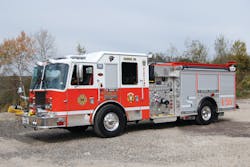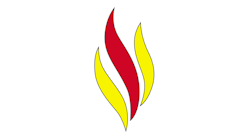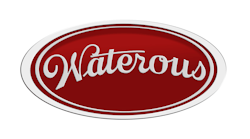Innovative Rigs on the Street: Freeland's 'Progressive' Engine
The Webster Collegiate Dictionary defines the word progressive in the following terms: “Making use of or interested in new ideas, findings or opportunities.” Since the inception of the Innovative Rigs on the Street articles back in December 2009, we have attempted to feature apparatus that have some distinctive, unique features that were designed to meet the needs of the local fire and emergency service organization.
If there is one constant that occurs as a result of our travels it’s that some of the most progressive-designed apparatus can be found in smaller communities where you might not expect to find them. As with many fire departments, the need to adapt to meet the needs of the local community while facing budgetary limitations seems to only enhance the capabilities that are designed into rebuilt and new fire apparatus. One such progressive department can be found in Freeland, PA, which lies just east of Interstate 81 between Wilkes-Barre and Hazelton in Luzerne County. During the early 20th century, coal mining was the principle industry and today the borough has a population of 3,600 residents.
About The Department
The department, under the command of Chief Joseph Stepansky, operates with two engines, a ladder truck and a utility support vehicle from one station. During 2011, the department responded to 280 incidents protecting the Borough of Freeland and surrounding communities. The Freeland Fire Department history goes back to 1989 when two independent fire companies that served the borough were merged together in an effort to improve fire protection services.
Over the years, Freeland has operated with a number of interesting pieces of apparatus including its first custom pumper in 1945 with the delivery a Seagrave 750 gpm unit equipped with a 250-gallon water tank. Due to the high elevation and topography in the area, in later years the department acquired several pumpers built by the FWD Corporation that featured four-wheel drive capabilities. The last of these units, a 1974 FWD pumper assigned as Engine 53, served the department until this past year when it was replaced by a KME Predator Panther model pumper.
Current apparatus include a 1992 Seagrave JB model 2,000 gpm pumper operating as Engine 54, a 1980 Seagrave WB model 100-foot rear-mount aerial that was rebuilt by Seagrave during 2005 and 2004 Ford F-550 four-door cab chassis equipped with a Four Guys body that carries support equipment. The latest acquisition, Engine 55 was placed into service in August 2011 after many months of research and planning by the department. Under the direction of Chief Engineer Cal Herring, the department had sought bid proposals from several manufacturers and ultimately chose to work with KME Fire Apparatus to build the replacement pumper for Engine 53, which had served the department for an amazing 37 years.
Engine 55 is built on a 193-inch wheelbase with an overall length of 32 feet, 5 inches. Maneuverability and turning radius was extremely important as many of the streets in the borough and surrounding areas are narrow and provide limited access. The size of this pumper, however, does not limit its fireground capabilities. The apparatus is equipped with a Waterous CSU fire pump rated at 2,000 gpm and carries 750 gallons of water.
Hoseloads
Most significantly, the engine is outfitted with nine preconnected attack lines, which enable this one apparatus to deliver a potent fireground punch when being supplied with some of the 1,700 feet of 5-inch supply line. A 3-inch front bumper discharge supplies a gated wye equipped with a 100-foot 2-inch attack line. The crosslay hose bed arrangement is comprised of two 150-foot long 2-inch attack lines together with a 150-foot preconnected 3-inch line outfitted with a water thief for use as a leader or set back line.
In addition to the 5-inch supply line the rear hose bed carries two 200-foot long, 2-inch attack lines, a 150-foot long, 3-inch line that supplies a portable deck gun, a 150-foot long, 3-inch leader line together with a 200-foot long, 2.5-inch attack line. All of the preconnected attack lines, with the exception of the front bumper line, are outfitted with smooth bore nozzles. After delivery, each of these discharges with flow test with the department’s hose and nozzles to determine the correct pump pressure for these lines in order to achieve the target flow rates.
Other master stream capabilities are provided by a portable 500 gpm monitor and a fixed monitor supplied by a 3-inch discharge from the pump. In order to provide adequate water supply for these lines, the apparatus is equipped with 6-inch inlets on each side with a 5-inch gated inlets provided at both the front and the rear. When operating from draft, the pump is equipped with a four-way priming valve that reduces the amount of time needed to pick up a prime from any one of the main pump suction inlets.
Around The Cab
Engine 55 is powered by a Caterpillar C-9 engine rated at 425 horsepower through an Allison EVS-3000 transmission. The KME cab provides seating for five personnel, an enclosed EMS cabinet and mounting for hand tools. The apparatus committee put a lot of thought into making tools and equipment accessible by grouping tools together that would be needed to successfully perform certain evolutions.
The apparatus body is constructed of 3/16-inch aluminum and is 100 inches wide to provide lower body compartments that are 26 inches deep in the lower section and 12 inches deep in the upper portion of the body. Several compartments are equipped with Performance Advantage Company Pac Trac tool-mounting boards that provide flexibility in mounting hand tools and other appliances. The right side of the apparatus is provided with a standpipe pack hose tray located under the ground ladders to accommodate hose packs for use in extending hose lines when needed. Recessed hose wells are provided on each side of the apparatus with a 21-inch deep rear step. The longer rear step was provided for sufficient room to mount both the small monitor and the portable deck gun for ease of deployment. The sides of the rear step were angled to improve swing clearance and aluminum rub rails were installed along the body to protect this area and the lift bar latches on the roll-up shutter doors.
An Onan 10Kw hydraulic generator provides power for an electric rewind cable reel together with several outlets and Fire Research scene lighting, which is provided at the front of the cab, side body area as well as telescopic lights located at the rear of the cab on each side.
The Freeland Fire Department members are justifiably proud of their new Engine 55, which continues the organization’s longstanding reputation for operating well designed and innovative apparatus. We would like to thank Chief Engineer Cal Herring for his cooperation in providing information for use in this article.
TOM SHAND is a 37-year veteran of the fire service having served with departments in Maryland, Pennsylvania and New York. He has worked in the fire apparatus industry since 1985, including 15 years with Saulsbury Fire Apparatus. He is a contributing editor to Fire Apparatus Journal and Firehouse Magazine and works with Mike Wilbur at Emergency Vehicle Response. He co-hosts the Apparatus Architects podcast with Wilbur, based on their column in Firehouse Magazine.








